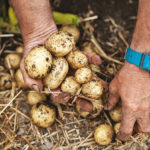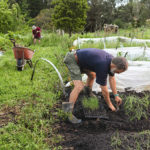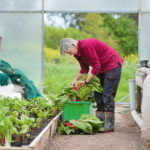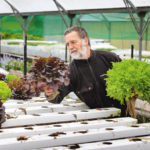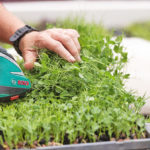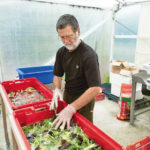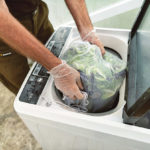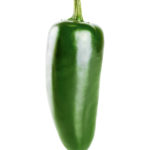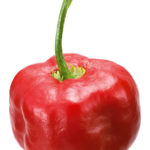Customers demanded hotter sauce: Tokomaru firm’s ghost chilli hot sauce wins big in international awards
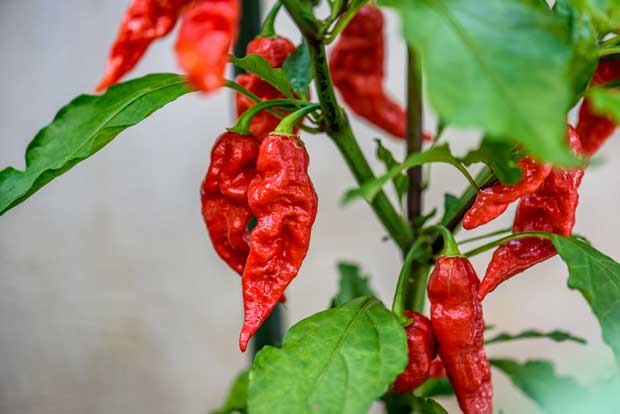
A mild-mannered couple are producing red hot, award-winning chilli products and running a sustainable business on their Horowhenua block.
Words Nadene Hall Photos: Brad Hanson
Who: Anne & Steve Corkran, Emoyeni Products
What: small-scale market gardeners and food producers
Where: Tokomaru, 20km south-west of Palmerston North
Land: 4ha (10 acres)
Markets: Feilding (every Friday, 9am-1.30pm), Hokowhitu (third Sunday of each month, 9am-1pm)
It’s not often a smack in the mouth is considered a compliment. But some of Anne Corkran’s award-winning chilli sauces are so hot, that’s how her daughter describes them.
Anne’s concoctions use chillies and other produce she and husband Steve grow on their block, 20 minutes’ drive south of Palmerston North. The couple has won multiple accolades in the last few years. They beat 80 other sauce-makers from Australia and New Zealand at Sydney’s Mr Chilli Awards. They’ve also been recognised at the Chilli Chompers Global Hot Sauce Awards, which features competitors from 10 countries.
Anne’s first attempt used a plum sauce recipe Steve’s mum gave to her; she just added chillies. Customers loved it, but they kept asking her to make something red hot.
“So, I used a tomato base – a very mild flavoured tomato base with a hint of tangelo – and piled the Ghost chillies into it. I asked Steve, ‘is that hot enough?’ And when he tried it, the first thing out of his mouth was, ‘holy sh*t, mother of god’.”
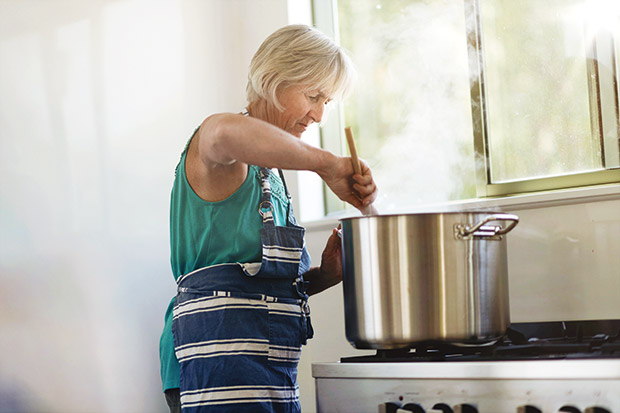
Anne is in charge of making the couple’s award-winning chilli sauces, jams, chutneys, and pickles in a certified kitchen on their block.
That’s how H.S. M.O.G. (Holy Sh*t, Mother of God) sauce came to be part of a range of products, including chutneys and jams, that Anne makes and bottles in her certified kitchen. The couple sells them online and at their regular farmers’ market stalls.
Her first saucy experiment for 2020 is called Glowing Ember. Anne says it starts off tasting like a good tomato relish, but then begins to smoulder in the mouth thanks to Carolina Reaper and Ghost chillies. Whether it makes it into their regular product range depends on customer feedback over the next few months. Other recipes have come about by accident.
“Last year, I made a batch of Black Boy chutney but it didn’t have any depth of flavour. Steve (my design team) had a bit of both chilli plum sauce and the Black Boy peach chutney on his plate. The flavour when they accidentally mixed was delicious. Black Boy peaches, plums and our first crop of Carolina Reapers produced a rich, full-flavoured sauce with smoldering heat. The first batch was called Dark Reaper Sauce; the second batch, with more chilli, was called Silent Assassin Sauce, up a few heat levels. Both batches sold out.”
Everything they make uses their homegrown chillies, fruit, and vegetables, mostly using plums as a base. The couple have to warn customers that the supply of sauces, jams, and chutney is always limited by their plum harvest.
“In the first six months (of 2019), we sold as (many products) as we did in the whole of 2018,” says Anne. “Today, I processed 91kg of plums, but once I run out of plums in the freezer, there’s no more (sauce).”
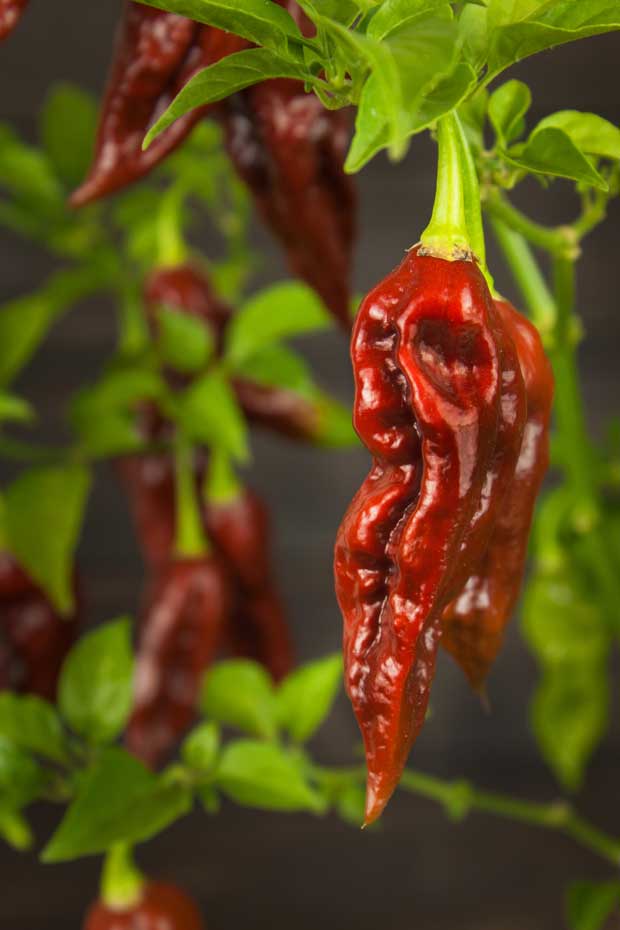
Ghost chillies,
The chillies may be the hottest stars on this block, but they’re just one small part of the incredible amount of fresh, spray-free fruit and vegetables the couple grows all year round. There are dozens of crops, from oyster mushrooms, culinary flowers, and hydroponic lettuce, to microgreens, baby ginger and turmeric.
Making a living growing and selling their produce was a long-time dream for Anne (59), a primary school principal, and Steve (58), a transport manager. For 30 years, they grew flowers commercially as a part-time hobby, first sandersonia, then calla lilies. They made the brave decision to quit their jobs and become full-time, small-scale, market gardeners in 2017.
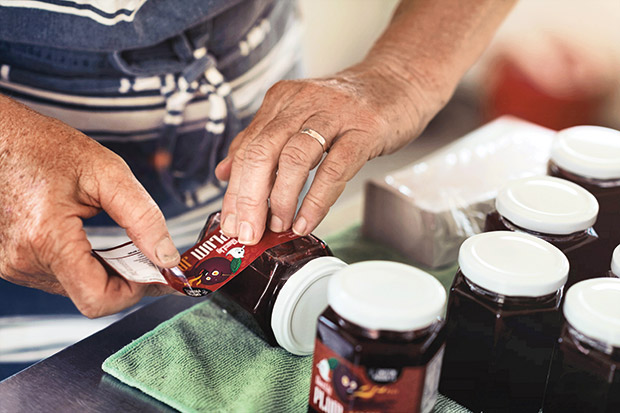
“I think you mean foolhardy,” laughs Steve. “We were burnt out from our jobs, and we’d talked about it for quite a few years. It was the right time for us; we had pretty hectic careers and we thought, ‘let’s get outside, do what we want, forget all the corporate stuff.'”
The first big decision was to agree on what they’d do if their dream of running a market garden were to fail. “We had to ask ourselves, would we be happy if we needed to sell the place?” says Anne. “When we could say, ‘yes, we can live with that,’ it took off a big layer of pressure.”
So far, the dream is thriving. All the crops are grown in raised beds as the soil on their sloping block is mostly hard clay. In the first year, they had six beds, 6.5m long by 1m wide. But their produce proved so popular, they couldn’t keep up with demand and the number of beds has exploded.
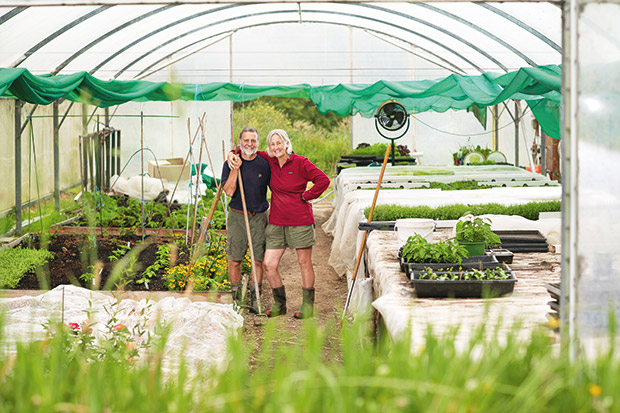
“Last year we went to 36 beds, same size,” says Steve. “Now we have another 40 beds, so by the end of the 2020 season we’ll have 110 beds in rotation, which will give us enough space to do carbon cropping, green manuring, and then rest the soil, so it builds up.”
At any time of year, around a quarter of the outdoor beds will be growing carbon or green crops. The Corkrans use wheat, corn, “and whatever else we can find,” says Steve.
“Then we chop it down, cover it with plastic and when our microgreens are finished, we put the compost from the trays on top and plant straight into it.”
- The couple planted four times as many potatoes for 2020 than they did in 2019, growing Swift Early, Jersey Bennie Early, Purple Heart Early/Late, and Summer Delight Late. .Anne says from November to January, they harvested over 300kg of potatoes.
- The oldest beds are now almost weed-free thanks to their organic methods.
- The natural soil is clay, so the couple has created a rich topsoil and grow everything in raised beds
- The couple grows dozens of different crops, including a rainbow range of beets.
Their system means one bed can produce 8-10 crops a year. “We rotate it, from a heavy feeder to a light feeder, then compost, then it gets a break and we cover it up, then the leafy greens follow the legumes, that sort of thing.”
Most of the original beds are now 90% weed-free. “We’re trying to get to zero weeding,” says Steve. “Because we mulch it and then compost it straight away after tilling, no weed seeds are coming through. It’s not like the old days when if we had bare soil, we had more weeds than seeds.”
They’ve had to accept they’ll always have slugs and snails but have found their organic methods help control numbers. “On the composted areas, we don’t get as much because there’s nothing for them to hide in,” says Steve. “It’s quite a ‘clean’ area and that cuts down on quite a bit of the competition. We also mow down low around the garden, so there’s no hiding areas.”
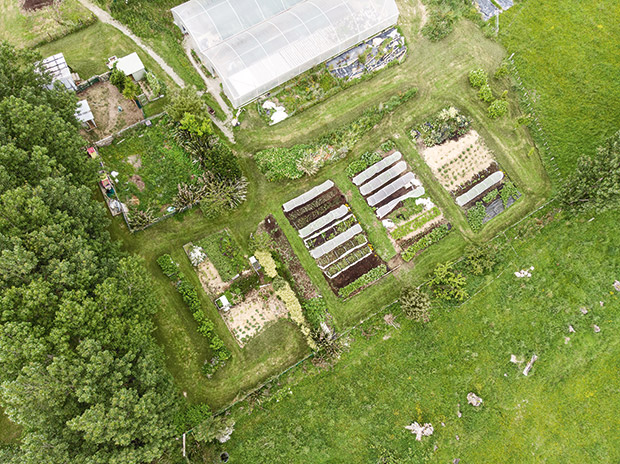
All the growing rows are covered with hoops and microclima, a knitted, plastic mesh. Originally it was to prevent rabbits from demolishing whole rows of young crops in one night, but the couple has found it has other big benefits.
“It’s sped up our growing cycle,” says Steve. “Plants are ready 2-3 weeks faster, and the health of the plants and their size is just so much bigger.
“We did quite a few comparisons (to check), covered rows and (uncovered) control rows,” says Anne. “In the carrots, it made a massive difference; seeds wouldn’t germinate when it was too hot, but because the cloth has 15% shade, the carrots still germinate even in the middle of a hot summer.”
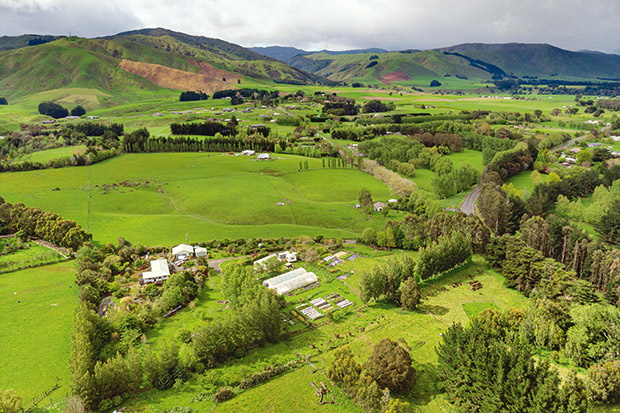
The couple’s block is named Emoyeni, inspired by a Wilbur Smith book.
The couple uses a Jang seeder. Anne fills the hopper, then pushes the seeder along prepared beds; seeds drop out at even spacings. “We’ve had that nearly two years, and it’s just so fast,” says Anne.
“You’re not having to go down a row and thin things. It’s a real time saver and we can plant more intensively.” The only machinery is a walk-behind, two-wheeled Grillo ‘tractor’ with rotary plough and tiller attachments, and a ride-on mower.
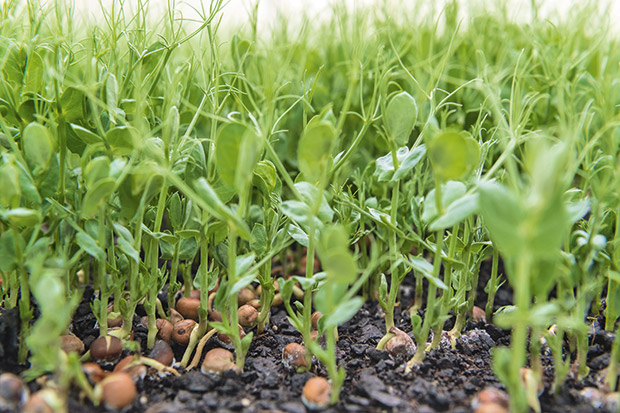
“My only other piece of equipment that’s mechanical is my hands,” says Steve. “We don’t want to get too intensive and tie up a lot of money in machinery. We got the tiller because it matches the width of our beds; one pass, up and down, and it’s ready to plant. I can do it now in 4-5 minutes, which saves 2-3 hours.”
It might sound like they have green thumbs, but Steve and Anne insist that isn’t the case.
“We’ve learnt by our mistakes,” says Steve. “Some years have been better than others, but our biggest thing is improving our soil activity. We have one experimental area that we’ve been cropping in the last couple of years, doing green crops, carbon crops, compost. (In 2019) it grew fantastic veggies, we didn’t water it, we didn’t dig it over, we didn’t do anything, and it cropped all year.”
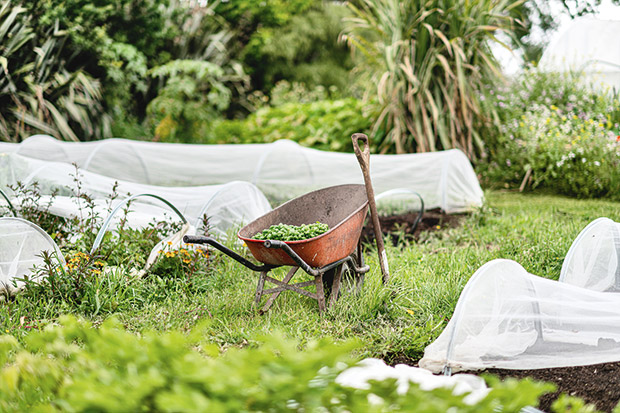
All the outdoor beds are covered with microclima mesh to protect them from rabbits, but there are growing benefits too.
The couple is now in Year 3 and say they’re happy with their progress.
“Things have exploded, far more than we expected,” says Steve. “If we do a cost-benefit analysis, the amount of effort we’ve put in has been worthwhile, and we’ll now focus on the (crops) that make us money.
“We were always quite happy for the first 3-4 years to give it a go, subsist on that and refine our processes, and then build on it. We’re keeping our heads above water, and the profit part is going to come later.
“The next step for us is to explore the opportunity to run courses, to assist people in gaining knowledge and confidence to make sauces, jams, preserves, and to create their own garden space for the individual, family, or on a larger scale to sell at markets and restaurants.”
THE BEST CROPS IN THE LOT
The couple’s biggest money-spinner is microgreens. That’s thanks to their fast growth, which means the couple has fresh crops to sell every 10 days.
“The microgreens came about after a conversation with my sister who had a restaurant in Western Australia,” says Anne. “She was talking about pea tendrils, and how they look really pretty on salads, and we wondered if you could get them here… and the (microgreens) grew from that conversation.”
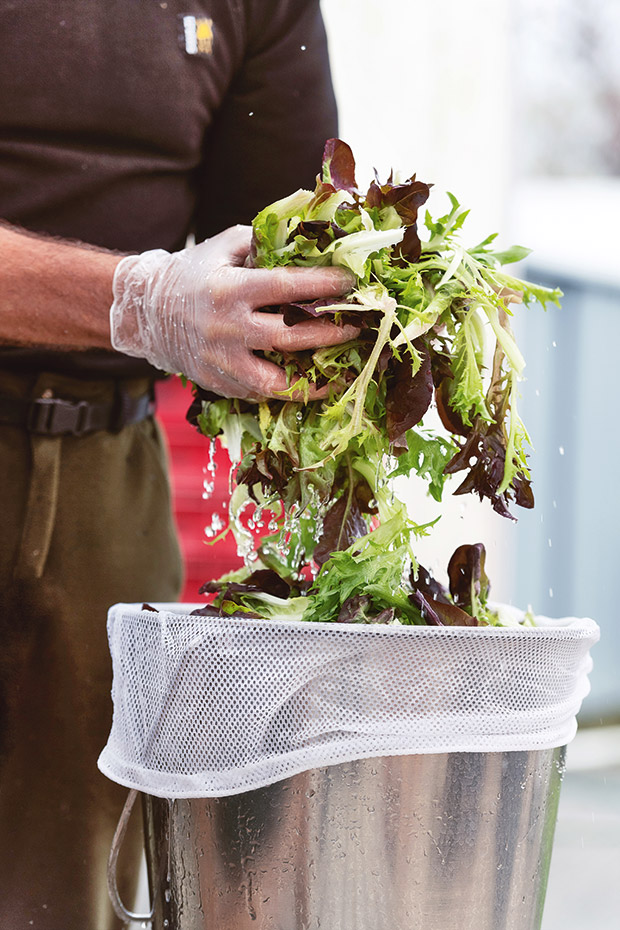
Their next best crop is the salad greens. “People love it that we’re spray-free, and local, and we only harvest the day before (sale),” says Steve. “They get 12 days life out of a salad bag, as opposed to supermarket varieties.”
Anne says many of their experimental crops have surprised them by quickly becoming best sellers.
“The ginger and turmeric was quite funny. We grew it for ourselves and couldn’t eat all of it, so thought we’d sell it, and it snowballed.”
In 2019, the couple built a 55m² tunnel house and filled it with turmeric and ginger. To encourage customers, Anne shares her cooking experiments. “You can use all parts of the turmeric plant. I only just found out about (the leaves), so I did a test-run; I got hamburger patties and wrapped them in the leaves. You get turmeric flavour, you get yellow juice, but it’s a slightly sweeter taste than the root. Apparently, you can also pound the leaf and make a paste to use in curries, but I haven’t tried that yet.”
- All the Corkran’s leafy plants are triple washed. Steve uses an old spa blower (to creates bubbles) to gently aerate water in a bin, helping to remove dirt and bugs. It takes just 4-5 minutes, compared to 10-15 minutes per bin to do it by hand.
- People look at Steve strangely when he pulls a large mesh bag of salad greens out of the washing machine, ready for packing.
Steve likes odd crops. When he got hold of a subtropical plant catalogue, he couldn’t help himself, despite their block’s non-subtropical climate. “We’ve got paw paw, sugar cane, bananas. The bananas are still growing even after being frosted a few times, we’re very impressed.
“The sugar cane is quite hardy, it looks like a bull rush and just keeps growing – I’ll probably make some alcohol with it.”
WHAT HAPPENS WHEN YOU EAT A RED HOT CHILLI
There are plenty of videos online of people trying super-hot chillies and suffering for it. Most people start confidently, but quickly begin burping, sweating, and swearing. That’s because the ‘hot’ ingredient in chillies – capsaicin – stimulates a pain response, not a taste response, says Dr John Prescott, an experimental psychologist and the author of Taste Matters.
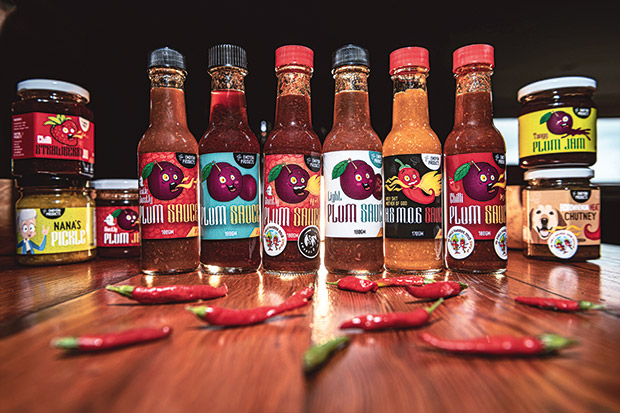
Capsaicin binds to pain nerve fibres on the lips, mouth, and tongue, causing inflammation. Mucous membranes try to flush it out, causing the nose and eyes to run and the mouth to water. Your brain believes that your body is burning, so it turns on sweat glands, and dilates blood vessels on the skin (which is why you turn beet-red) in a bid to cool it down.
Yoghurt and creamy milk help quell the pain response as capsaicin is fat-soluble. Source: www.vice.com
MEET THE CHILLIS
The heat factor of a chilli variety depends on the concentration of capsaicin in it, measured by Scoville heat units (SHU). The SHU is given as a range, as heat levels in the same variety depend on the seed quality, climate, and growing conditions of individual plants.
The common capsicum has a heat factor of 0-100 SHU. The chilli varieties Steve and Anne grow range from low to some of the hottest on the planet.
- Ancho
- Jalapeno
- Pablano
- Ghost (Bhut Jolokia)
- Cayenne
- Habanero
Ancho – red, called Poblano when green and unripe (1000-1500 SHU)
Mulato – chocolate (2500-3000 SHU)
Cayenne – red (10,000-100,000 SHU)
Thai Super – red (30,000-50,000)
Rocoto – red (30,000-100,000)
Habanero – red, peach, yellow (100,000-400,000 SHU)
Ghost – Bhut Jolokoia, also called Ghost chillies, red, yellow, chocolate (1 million SHU)
Carolina Reaper – red, yellow (800,000-3.2 million SHU)
HOW THEIR BLOCK GOT ITS NAME
Emoyeni is named after a farm in the Wilbur Smith book, A Sparrow Falls. It’s a Zulu word meaning ‘place of wind’ or ‘spirit and soul’ and a perfect description of their block say Steve and Anne, who have lived there since 1992.
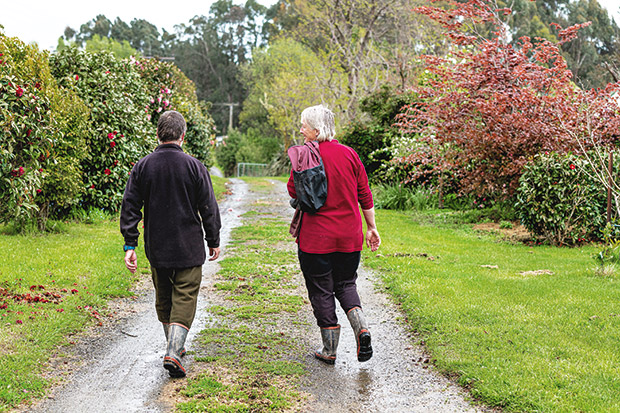
Despite planting a lot of shelter trees, they’re still occasionally hammered by the region’s infamous gale force winds. “You sometimes get stuff growing horizontally,” says Steve. “But we don’t water our orchards. The trees either live or die. It’s tough love.”
ANNE’S RED HOT CHILLI TIPS
1. Finely dice a chilli of your choice and mix it through salads for tiny flavour shots.
2. Lightly dust dried cayenne chilli flakes over grated chocolate on top of a cappuccino – this is Anne’s morning starter drink.
3. Add finely diced chilli to marinades.
4. Add whole or chopped chillies to pickles, eg pickled onion, pickled baby ginger – Anne is also going to try fermenting some.
5. Slice onions, garlic, chilli, oyster mushrooms, zucchini, tomatoes, add Cajun seasoning, and cook on the barbecue. Spoon onto a hamburger or try on its own inside a bun.
6. Mix a few cayenne flakes into a fruit salad and leave it to sit for at least two hours before serving.
MORE HERE:
How these red hot chilli growers turned their Horowhenua block into a small-scale market garden
